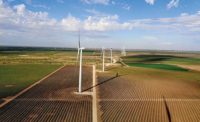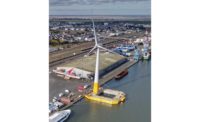From water depth to turbine sizes, everything about European offshore-wind power is getting larger, except cost.
Maturing technology and increasing competition have helped to reduce costs, making offshore power increasingly competitive with onshore, according to some analysts. “The industry has become more masterful at driving down cost,” says Huub den Rooijen, head of offshore wind at Crown Estates, which grants 50-year leases for U.K. wind-farm sites—excluding Scotland, as of this month. “There have been improvements in every single aspect,” he adds.
The U.K. Offshore Renewable Energy Catapult, a national R&D center, reported a 32% drop in whole-life net-present costs of offshore-wind energy in the past five years, with “high industry confidence” in continuing declines. As the industry matures, investor interest has become “huge,” adds Tom Harries, wind-energy analyst at Bloomberg New Energy Finance, London. “The risk appetite has changed. People are much more comfortable with the construction risk.”
European offshore-wind power investments last year rose nearly 40% over 2015, with 11 projects financially committed, says Brussels-based trade group WindEurope. Of $19.7 billion in total financing, over half was in the U.K. and the rest spread over four countries.
|
Startup of First U.S. Offshore Wind Farm Propels Domestic Market |
European offshore development has centered on the U.K. partly because its “resources are world-class in terms of seabed, water depth, wind speed, plant and labor,” says den Rooijen. More than 5 GW of wind capacity now operates in U.K. waters, with 5 GW in construction, 9 GW in planning and 12 GW under development.
Around Europe, nearly 3,600 turbines totaling 12.6 GW now are grid-connected, says WindEurope. With 11 projects under construction in Belgium, Germany, Holland and the U.K., total installed capacity is set to reach nearly 25 GW by 2020.
Only China comes close to Europe, with 1.6 GW installed by late 2016, adds the Belgium-based Global Wind Energy Council. Japan has 60 MW, which is twice the U.S. capacity.
A key driver has been the European Union’s 2009 Renewable Energy Directive, which requires member states to secure at least 20% of energy needs from renewables by 2020, says Joël Meggelaars, WindEurope’s political affairs adviser. European states last year agreed to cooperate over future North Sea developments on technical standards and other key issues, including grid development. “Grids must evolve to handle fluidity of supply as well as fluidity of demand,” says den Rooijen.
The scale of projects has taken giant steps since the world’s first offshore farm, off Denmark, started operations 25 years ago. Now being retired, the 0.45-MW Vindeby farm’s capacity of 11 turbines is half that of a single modern turbine.
When developers started taking U.K. offshore leases 17 years ago, projects were typically close to shore and averaged 100 MW; those now being grid-connected average 380 MW and are typically in 30 meters of water more than 40 kilometers from shore.
And the scale keeps growing. Next year, Denmark’s Dong Energy plans to start offshore work on the world’s largest farm—the 1.2-GW One Hornsea project—120 km off Yorkshire, England’s coast. It also obtained consent for the 1.8-GW Hornsea Project Two. These projects dwarf the current record-holder, the 630-MW London Array, off Kent.
Having been the first to take the offshore plunge, Dong is now the market leader, last year developing over 16% of Europe’s capacity, reports WindEurope. On its heels are Sweden’s Vattenfall A.B (8.6%), followed by E.ON (8.3%), Innogy (7.8%) and Stadtwerke München (4.2%), all of Germany. On the hardware front, German manufacturer Siemens Wind Power dominates Europe’s turbine market, accounting for more than 98% of the new 344 grid-connected installations last year; Denmark’s MHI Vestas Offshore Wind supplied the balance.
As developments reach into deeper waters, interest in floating turbines grows. Among the innovators is France’s Ideol S.A., whose 2-MW “Floatgen” demonstration project is taking shape at a French site. In June, Bouygues Travaux Publics will complete casting the 36-sq-m, 9.5-m-tall caisson-like concrete foundation there, says an Ideol spokeswoman. Two years of sea trials are set to start late this year. Ideol also is developing steel-and-concrete demonstration projects in Japan and has signed two recent agreements to seek prospects around the U.K. and the Irish Republic.
While offshore technology improves, the pipeline is uncertain for projects after the current batch is completed, says Andrew Ho, WindEurope senior analyst. But prospects should become clearer in the next few years as E.U. states announce plans to achieve the recently proposed renewables target of 27% of total energy needs by 2030, he adds. European offshore-wind power is “far away from peaking.”






Post a comment to this article
Report Abusive Comment